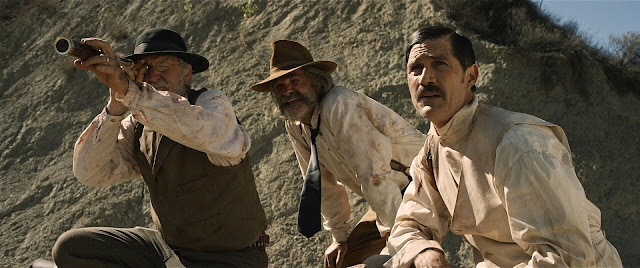Weird Westerns: Bone Tomahawk (2015)
★★★★☆
A superb story of a kidnapping, a search party, and subhuman cannibals that nonetheless has troubling subtext.
By Max Sparber
"Bone Tomahawk" starts with a terrific little introductory scene in which two bandits, played by horror great Sid Haig and professional eccentric David Arquette, kill a couple of men, steal their possessions, and then stumble into an encampment of cannibalistic troglodytes, all while having a jittery, ridiculous discussion that plays out sort of like Samuel Beckett on the frontier, if Beckett ended his plays with a man's throat getting torn out.
This is one of two really terrific Western horror films about cannibalism, the other being "Ravenous," which also featured David Arquette, making him American's premiere actor on the subject. I hope future filmmakers remember this and Arquette spends the rest of his career making a frontier man-eater film every decade or so, and I hope they are all as good.
But most of the film follows a posse, hastily assembled by Kurt Russell, playing a grizzled and short-tempered Western sheriff. His deputy has been kidnapped by the troglodytes, along with the wife of a local cowboy, played by Patrick Wilson. He's suffering from a broken leg, but won't be dissuaded from going after her; neither will his elderly assistant deputy, delightfully played by Richard Jenkins.
Neither would be the best option for a posse; Jenkins is handier than his doddering suggests, but is a little long in the tooth for this sort of work, and Wilson's leg worsens to the point where it will likely need to be amputated. A third man, a dandy who boasts of his Indian killing prowess, tags along, played by Matthew Fox; he's more able than the other two, but is also racist to a degree that shocks the other men.
The film follows a nearly perfect three act structure, with the entire second act spent in the desert, getting to know this men. The film was written and directed by S. Craig Zahler, a novelist and screenwriter making his directorial debut. His visual sensibility sometimes comes up a little short — the film is good to look at, but often a bit anonymous — but his screenplay is a delight. He fills his scenes with a mixture of cantankerousness and wry humor, with Jenkins getting a lion's share of the most memorable dialogue. "This tastes like corn," Jenkins complains at one point, sipping soup. "It's corn chowder," Russel responds, and Jenkins nods, sagely, saying, "Then things are lining up."
As cantankerous as the men are, it's hard not to like them, or, most of them, anyway. Russell, wearing a huge, bushy mustache and beard (it would get bigger; he was growing it out for "The Hateful Eight"), is laconic and authoritative. Wilson is determined to rescue his wife in a desperate, heedless manner that is often heartbreaking, especially as he reveals himself to be essentially decent. Jenkins grows from comic relief to the film's oddball voice of moral conscience, viewing the world through jaundiced but essentially compassionate eyes. Fox never ceases to be a racist, but, I suppose, in a fight, even a racist can be handy.
The film reserves most of its horror for its final act, when two of our heroes are captured by the troglodytes, tortured in a cave, witness a the brutal slaughter of Russell's other deputy, and must rely on their limited resources, wits, and a broken-legged man on the outside to save them. The violence in these scenes in genuinely gruesome and horrifying, causing some critics to claim the film was "The Searchers" with "Cannibal Holocaust" tacked on at the end, which is a fair description. Even for fans of horror films, the violence is intense, especially since it happens to character we have come to care for. For fans of Westerns who are not acclimated to the visceral climaxes of horror films, it may be too much.
I should note that the troglodytes are essentially filling in for Native Americans in this film, and while the script is careful to lampshade the fact that they are not Indians — including a stern lecture from Native American actor Zahn McClarnon that only a racist would confuse one for the others — there's no real getting around it. At its core, "Bone Tomahawk" is a nightmare inspired by the darkest stories about white people kidnapped by Indians.
So there is no getting around the fact that it is a nightmare of the colonizers about the colonized, and I realize that the Indians here have been swapped out for cavemen, but this is a substitution rather than a correction: the cavemen still have all the qualities that the colonist racist imagination associated with Indians, including violence, primitivism, savagery, and cannibalism.
It's as though contemporary Germans made a film set prior to the Holocaust about everyday Germans being menaced by rootless cosmopolitans, but rather than have the menace be Jews, the film simply made them literal vermin, which is what the Nazis accused the Jews of being.
I don't think "The Burrowers" is as good a horror film as this one. It doesn't have the same ear for language, the same depth of character, or the same extraordinary cast, and it isn't nearly as terrifying. But I think it handled this basic issue better, in that it also retold the story of "The Searchers," but also with man-eating monsters at the end.
But "The Burrowers" did something that this film didn't; it reversed the story's villainy, so that it was the largely White posse that was the source of evil, and not the Native Americans or their proxies. Because, while I will admit this is subtext, in the story of the American West, especially the story of the war of genocide against this country's native population, subtext is awfully important.



Comments
Post a Comment